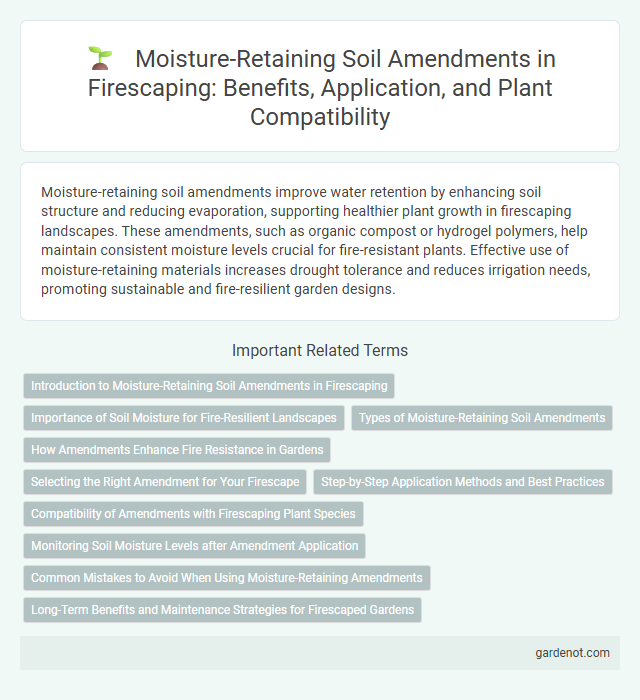Moisture-retaining soil amendments improve water retention by enhancing soil structure and reducing evaporation, supporting healthier plant growth in firescaping landscapes. These amendments, such as organic compost or hydrogel polymers, help maintain consistent moisture levels crucial for fire-resistant plants. Effective use of moisture-retaining materials increases drought tolerance and reduces irrigation needs, promoting sustainable and fire-resilient garden designs.
Introduction to Moisture-Retaining Soil Amendments in Firescaping
Moisture-retaining soil amendments enhance soil's ability to retain water, crucial for firescaping where drought-resistant landscapes are essential. These amendments, including hydrogels, organic mulches, and compost, improve soil structure and moisture availability, promoting plant resilience during wildfire threats. Incorporating moisture-retaining amendments reduces irrigation needs and supports fire-adapted, sustainable vegetation in fire-prone areas.
Importance of Soil Moisture for Fire-Resilient Landscapes
Soil moisture plays a critical role in fire-resilient landscapes by enhancing plant hydration and reducing flammability. Moisture-retaining soil amendments like hydrogels, compost, and biochar improve water retention, promoting healthier vegetation with higher fire resistance. Maintaining adequate soil moisture directly contributes to slowing fire spread and protecting property during wildfire events.
Types of Moisture-Retaining Soil Amendments
Moisture-retaining soil amendments are essential for firescaping to reduce irrigation needs and enhance plant survival during dry spells. Common types include hydrogels, which absorb and gradually release water; organic matter such as compost or peat moss, which improves soil texture and moisture retention; and biochar, which increases soil porosity and holds water effectively. Selecting the appropriate amendment depends on soil type, plant species, and local fire risk management requirements.
How Amendments Enhance Fire Resistance in Gardens
Moisture-retaining soil amendments such as biochar, compost, and vermiculite improve fire resistance in gardens by increasing the soil's water-holding capacity, which helps keep plants hydrated during dry conditions. These amendments lower soil temperature and reduce the likelihood of ignition by maintaining higher moisture levels around plant roots and foliage. Enhanced soil moisture also promotes healthier plant growth, making vegetation less flammable and more resilient to wildfire exposure.
Selecting the Right Amendment for Your Firescape
Choosing the right moisture-retaining soil amendment for your firescape involves evaluating materials like hydrogels, compost, or coconut coir for their water retention capacity and compatibility with native plants. Prioritize amendments that improve soil structure and promote deep root growth to enhance resilience against fire-related drought stress. Incorporating organic matter with high porosity supports long-term moisture availability, critical for fire-adapted landscaping.
Step-by-Step Application Methods and Best Practices
Moisture-retaining soil amendments like water-absorbing polymers or organic compost should be evenly mixed into the top 6-12 inches of soil to enhance water retention and plant resilience in firescaped areas. Begin by lightly loosening the soil, incorporate the amendment according to product recommendations, and then thoroughly water the area to activate moisture absorption. Regular monitoring of soil moisture levels and reapplication during dry periods ensure optimal fire-resistant landscaping benefits.
Compatibility of Amendments with Firescaping Plant Species
Moisture-retaining soil amendments such as hydrogels, compost, and coconut coir enhance water retention and improve drought resilience in firescaping environments. Compatibility with firescaping plant species like lavender, sage, and manzanita is crucial; these plants thrive in well-drained soils amended to retain moisture without becoming waterlogged. Selecting amendments that maintain a balance between aeration and moisture ensures optimal root health and supports fire-resistant landscaping goals.
Monitoring Soil Moisture Levels after Amendment Application
Monitoring soil moisture levels after applying moisture-retaining soil amendments is crucial for effective firescaping. Using soil moisture sensors or tensiometers provides accurate data to ensure the soil maintains optimal hydration for fire-resistant plants. Regular assessment helps prevent overwatering or drought stress, enhancing plant health and resilience against fire hazards.
Common Mistakes to Avoid When Using Moisture-Retaining Amendments
Applying excessive moisture-retaining soil amendments can lead to waterlogged conditions that promote root rot and fungal diseases, undermining plant health. Using inappropriate amendment types, such as those incompatible with local soil pH or texture, reduces water retention efficiency and nutrient availability. Failing to evenly distribute the amendment results in uneven moisture levels, causing stress to plants and defeating the purpose of firescaping soil management.
Long-Term Benefits and Maintenance Strategies for Firescaped Gardens
Moisture-retaining soil amendments enhance water retention in firescaped gardens, reducing irrigation needs and promoting plant resilience during droughts. These amendments improve soil structure by increasing organic matter, leading to better root development and sustained moisture availability over time. Regular replenishment of amendments and mulching are essential maintenance strategies to preserve soil hydration and optimize fire-resistant landscaping performance.
Moisture-retaining soil amendment Infographic

 gardenot.com
gardenot.com